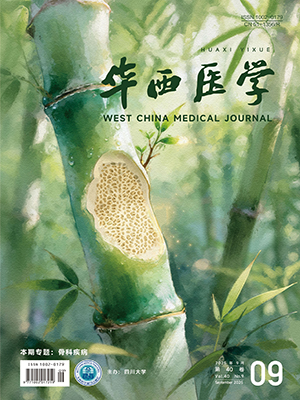| 1. |
许银丽. 产妇精神因素及分娩方式对产后出血的影响及护理对策. 中国实用护理杂志, 2011, 27(18): 52-53.
|
| 2. |
雷凤琼, 冯春, 周倩. 瑞芬太尼主导多维模式分娩镇痛对新生儿 Apgar 评分的影响及镇痛效果. 中国妇幼保健, 2015, 30(17): 2771-2773.
|
| 3. |
张亚云, 王明明, 孙铮. 麻醉护士的工作压力源及其应对方式的质性研究. 中国实用护理杂志, 2016, 32(20): 1579-1582.
|
| 4. |
刘晓艳, 叶霞, 王小芳. " 医护一体化”疼痛管理模式在骶骨肿瘤患者围手术期的应用. 华西医学, 2013, 28(4): 582-584.
|
| 5. |
杨益琼, 巫万玺, 张丽萍. 住院患者疼痛管理现状及满意度调查分析. 华西医学, 2013, 28(12): 1909-1913.
|
| 6. |
郭利红, 师文. 手术室护士术前访视的情景模拟训练及效果. 中华护理杂志, 2014, 20(3): 371-373.
|
| 7. |
武晓丹, 顾春怡, 张铮, 等. 助产护士产前门诊对初产妇心理状态、满意度及分娩结局的影响. 中华护理杂志, 2012, 47(7): 581-584.
|
| 8. |
倪忆媚, 叶丽, 唐红艳. 自控静脉镇痛在剖宫产产妇术后镇痛中的效果评价. 华西医学, 2015, 30(1): 148-149.
|
| 9. |
Hawkins JL. Epidural analgesia for labor and delivery. N Engl J Med, 2010, 362(16): 1503-1510.
|
| 10. |
The American College of Obstetricians and Gynecologists and the Society for Maternal-Fetal Medicine. Safe prevention of the primary cesarean delivery. Obstet Gynecol, 2014, 123(3): 693-711.
|
| 11. |
王海燕, 许燕玲, 胡三莲, 等. 多模式镇痛方法对跟骨骨折术后患者镇痛效果的影响. 中国实用护理杂志, 2016, 32(23): 1788-1790.
|
| 12. |
顾娟, 陈杰, 陈元敬. 瑞芬太尼用于全身麻醉剖宫产对新生儿影响的 Meta 分析. 华西医学, 2012, 27(9): 1361-1365.
|
| 13. |
胡敏, 黄建琼, 周敏. 隆乳术后使用静脉自控镇痛泵的镇痛效果调查分析. 华西医学, 2015, 30(3): 545-547.
|
| 14. |
李志超, 王煜, 王小成, 等. 基于快速康复外科理念的疼痛管理模式在日间腹腔镜胆囊切除术的应用. 华西医学, 2015, 30(5): 804-807.
|
| 15. |
尚建英, 李桂蓉, 曾晓红. 人本理念在基层医院优质护理服务中的应用. 华西医学, 2015, 30(1): 119-122.
|




